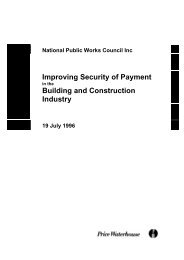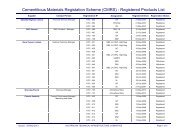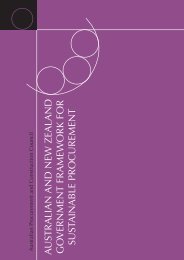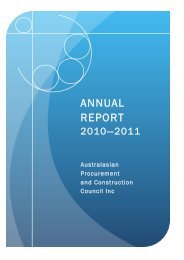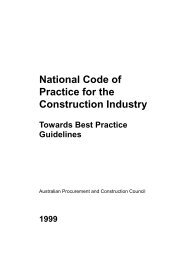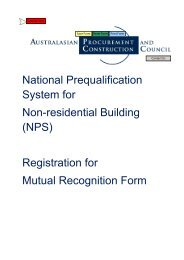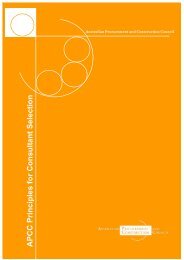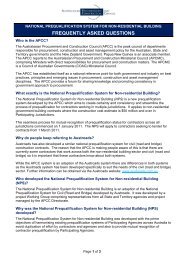(NPS) Guidelines - Australian Procurement and Construction Council
(NPS) Guidelines - Australian Procurement and Construction Council
(NPS) Guidelines - Australian Procurement and Construction Council
Create successful ePaper yourself
Turn your PDF publications into a flip-book with our unique Google optimized e-Paper software.
4. Financial capacity<br />
To be considered for prequalification <strong>and</strong> to maintain prequalification status, applicants must<br />
demonstrate strong business viability. However, any jurisdiction-specific builder’s licensing financial<br />
requirements <strong>and</strong> associated prequalification requirements will take precedence over these<br />
requirements for that jurisdiction. Applicants must produce externally audited (ASIC Certificate of<br />
Registration) accounting statements for the last three years.<br />
The following criteria for financial capacity will be assessed to determine suitability for <strong>NPS</strong><br />
prequalification.<br />
The Applicant (the legal entity seeking <strong>NPS</strong> prequalification) must have:<br />
a) as a minimum, a current ratio of 1<br />
b) net tangible assets that are not less than 5% of the Applicant’s average previous three<br />
years’ financial turnover<br />
The maximum financial capacity will be based on the lesser of the following:<br />
a) 100% of the Applicant’s average previous three years’ financial turnover<br />
b) 10 times working capital<br />
In calculating the above financial criteria <strong>and</strong> maximum financial capacity, assets <strong>and</strong> liabilities will be<br />
allowed where it can be demonstrated that they can be relied upon for the purpose of supporting the<br />
entity in the event of default or insolvency (at the sole discretion of the Assessing Agency). Examples<br />
of these assets <strong>and</strong> liabilities may include all contingent assets, all shareholder loans, all related entity<br />
loans <strong>and</strong> all related entity investments.<br />
However, under the financial requirements of Queensl<strong>and</strong>’s Prequalification (PQC) System for building<br />
industry contractors related entity loans <strong>and</strong> investments are excluded from net tangible assets. Other<br />
exclusions are detailed at:<br />
http://www.works.qld.gov.au/downloads/bpu/contractor_pqc_finreq.pdf. In this context<br />
prequalification under the <strong>NPS</strong> in Queensl<strong>and</strong> will be limited by the particular requirements of<br />
Queensl<strong>and</strong>’s PQC System.<br />
In the case where an Applicant is assessed by Queensl<strong>and</strong>, <strong>and</strong> the Applicant has requested mutual<br />
recognition by other jurisdictions, the <strong>NPS</strong> financial assessment criteria will apply for the purposes of<br />
mutual recognition.<br />
In some cases, a Participating Agency may allow mutual recognition where the Applicant provides a<br />
letter of undertaking or acceptable Deed of Company Guarantee from a related or other company in a<br />
form approved by the Participating Agency. The requirement <strong>and</strong> nature of the letter of undertaking or<br />
Deed of Company Guarantee will be at the sole discretion of each Participating Agency.<br />
The rules applicable to calculating net tangible assets apply to the calculation of working capital.<br />
Determining Maximum Contract Value<br />
The maximum contract value for which the Applicant will be prequalified to tender will be determined<br />
on the basis of the lesser of:<br />
the highest value of any successfully completed contract – as per Criterion 3; <strong>and</strong><br />
the contractor’s financial capacity – as per Criterion 4.<br />
Page 13 of 20


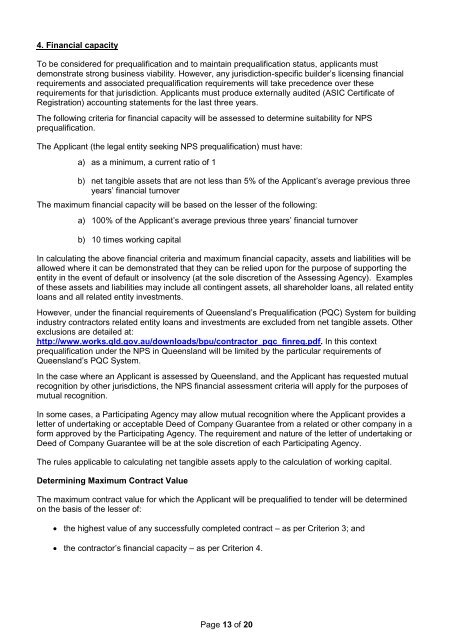
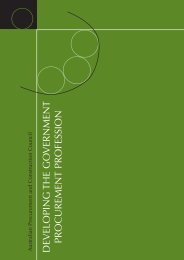
![NATIONAL COST ADJUSTMENT PROVISION EDITION 2 [NCAP2]](https://img.yumpu.com/48266135/1/184x260/national-cost-adjustment-provision-edition-2-ncap2.jpg?quality=85)
